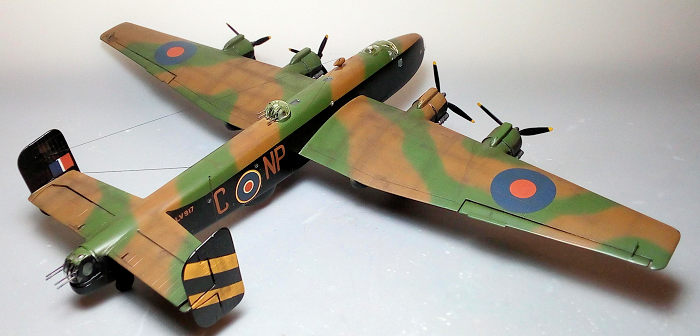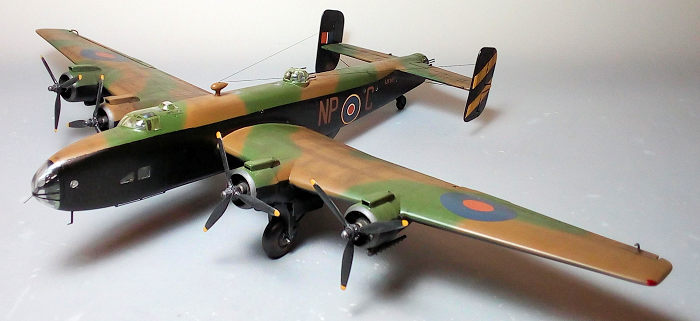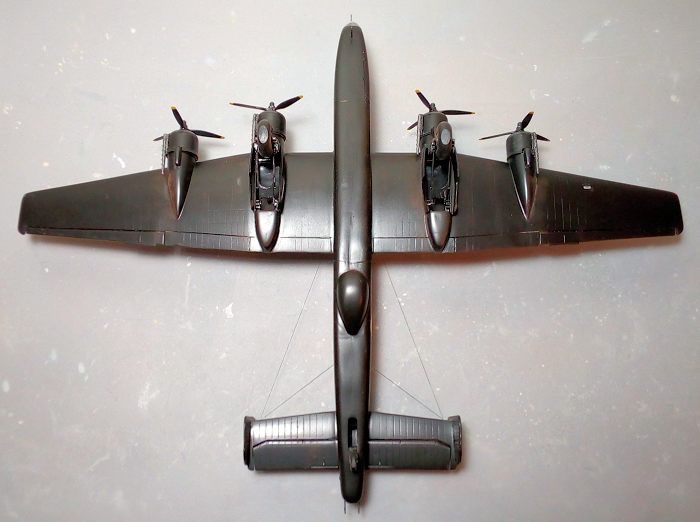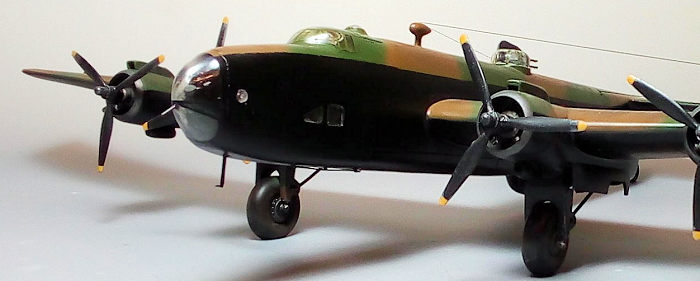Airfix 1/72 Halifax B.III
|
KIT #: |
06008 |
|
PRICE: |
$10 in 2005 |
|
DECALS: |
One option |
|
REVIEWER: |
Spiros
Pendedekas |
|
NOTES: |
|

The Handley Page Halifax was four-engined heavy bomber, developed by
to the same specification as the contemporary twin-engine Avro Manchester.
Its origins can be traced in the twin-engine HP56 proposal of the late
1930s, itself being a backup to the Avro 679, with both of them designed to
use the Rolls-Royce Vulture engine.
Seemingly due to the risk posed by the underperforming Vulture, the Handley
Page design was wisely altered at the Ministry to a four-engine arrangement
powered by the Rolls-Royce Merlin, whereas the Avro 679 evolved into the
Avro Manchester. The latter, though regarded as unsuccessful mainly due to
the Vulture engine, was a direct predecessor of the famed Avro Lancaster
with, finally, both the Lancaster and the Halifax emerging as capable
four-engined strategic bombers.
In RAF service, the Halifax quickly became a major component of Bomber
Command, performing routine strategic bombing missions against the Axis
Powers, many of them at night. Arthur Harris, the Air Officer
Commanding-in-Chief of Bomber Command, described the Halifax as inferior to
the  rival Lancaster (in part due to its smaller payload) though this opinion
was not shared by many of the crews that flew it, particularly the MkIII
variant.
rival Lancaster (in part due to its smaller payload) though this opinion
was not shared by many of the crews that flew it, particularly the MkIII
variant.
During their service with Bomber Command, Halifaxes flew a total of 82,773
operations and dropped 224,207 tons of bombs, while 1,833 aircraft were
lost. The type was also flown in large numbers by other Allied and
Commonwealth nations, such as the RCAF, the RAAF, the Free French and Polish
air forces.
Various improved versions were introduced, incorporating more powerful
engines, a revised defensive turret layout and increased payload. It
remained in service with Bomber Command until the end of the war, performing
a variety of duties in addition to bombing, with specialized versions being
developed for troop transport and paradrop operations.
Following the end of the Second World War, the RAF quickly retired the
Halifax, after it was succeeded as a strategic bomber by the (Lancaster
derivative) Avro Lincoln, but the Halifax continued to be operated by the
Royal Egyptian Air Force, the French Air Force and the Royal Pakistan Air
Force. It also entered commercial service for a number of years, used mainly
as a freighter. A dedicated civil transport variant, the Handley Page Halton,
was also developed and entered airline service. 41 civil Halifax freighters
were used during the Berlin Airlift, with the last remaining Halifax bombers
were retired from operational use in 1961.
The Halifax was a solid, orthodox design that provided good service,
performing well in its allocated tasks. In total 6,176 examples were built.
Airfix introduced this venerable kit in 1961, regularly reboxing it ever
since with occasionally different decals. My copy was the 1993 rebox,
discovered still wrapped in 2005 at a toy/hobby shop and carrying a low
price.
 The kit came in the usual big, nice and sturdy Airfix top opening box,
featuring an attractive box art of three Halifaxes, presumably on their way
to a bombing mission. Upon opening the box, I was greeted with 102 black and
somehow brittle styrene parts. The fuselage, wing and aileron halves are
separately provided, whereas all the rest of the parts were arranged in four
sprues. Molding is reminiscent of the kit’s 60s origins with acceptable
basic shapes but otherwise plain details. Apart from the moving surfaces
borders, all other panel lines are raised and done in “rivet” style,
actually not looking too bad, especially if toned down with some light
sanding. There is a certain amount of flash to be cleaned, which will not be
an easy task in the case of smaller parts, due to the brittleness of the
plastic.
The kit came in the usual big, nice and sturdy Airfix top opening box,
featuring an attractive box art of three Halifaxes, presumably on their way
to a bombing mission. Upon opening the box, I was greeted with 102 black and
somehow brittle styrene parts. The fuselage, wing and aileron halves are
separately provided, whereas all the rest of the parts were arranged in four
sprues. Molding is reminiscent of the kit’s 60s origins with acceptable
basic shapes but otherwise plain details. Apart from the moving surfaces
borders, all other panel lines are raised and done in “rivet” style,
actually not looking too bad, especially if toned down with some light
sanding. There is a certain amount of flash to be cleaned, which will not be
an easy task in the case of smaller parts, due to the brittleness of the
plastic.
Interior, including the turrets, is as plain as it can get, with mummy crew
figures to be attached, trying to fill the emptiness. The engines are molded
with the cowlings and are passable, as are the exhausts, landing gear parts
and wheels, but the same cannot be said for the totally empty landing gear
bays. Ailerons, rudders and main wheels are moveable, with optionally
retracted landing gear. No bomb bay is provided, with the doors molded
closed.
Transparencies are thick with the framings barely distinguishable.
Instructions are provided as a leaflet, containing a short history of the
type, with the construction spread in 17 followable steps. Neither interior
nor bays or engines color callouts are given, with the latest (2014)
reboxing instructions stating Hu78 as interior color.
Only one scheme is provided, that of 158 Squadron’s LV917/NP-C at the
classic dark earth/dark green over black, with decals looking usable. By
netting, I found that LV917, at least from a point onwards, was named
“Clueless”, carrying a distinctive nose art, which is not provided by the
decal sheet. That the kit scheme depicts LV917 before the nose art
application is not a totally unrealistic assumption. The upper /lower
demarcation line is also depicted either straight or wavy at
various profiles. Colors are given in both Airfix codes and generic names.
 Instructions want you to first assemble the crew compartment and turrets,
then trap them, together with the rear wheel, between the fuselage halves,
having affixed the side windows from the insides before. The twin tail and
wings are next assembled and attached, followed by the optionally moveable
rudders, elevators and ailerons. The canopy and top transparencies are to be
attached at this time, as well.
Instructions want you to first assemble the crew compartment and turrets,
then trap them, together with the rear wheel, between the fuselage halves,
having affixed the side windows from the insides before. The twin tail and
wings are next assembled and attached, followed by the optionally moveable
rudders, elevators and ailerons. The canopy and top transparencies are to be
attached at this time, as well.
The inner nacelles that extend as wheel bays are then assembled with the
main landing gear legs trapped. The outer nacelles come next and all four
are attached under the wings, with the four engines, their exhausts and
props following. Finally the four engine inlet ducts, the top DF loop
antenna, the bottom aerial array, the aileron mass balances and the front
glazing are to be attached, in order to conclude what looks a
straightforward and relatively uncomplicated build.
I do have a soft spot for older kits, which is
even softer for Airfix multi-engine bombers, so I joyfully unwrapped the
attractive Airfix box and started putting the Halifax together!
I began by attaching the side windows from the insides of the fuselage
halves. The crew compartment was then assembled and then trapped between the
fuselage halves, together with the rear wheel. Basic interior color was Hu78
cockpit Green with black instrument panel. I did not spend any more time in
the interior, since little would be visible through the thick
transparencies. The rear turret was also supposed to be trapped between the
fuselage halves, but, in order to facilitate painting, I decided to attach
it at later stages by shaving off its base mounting lug.
 The 2-piece wings were then assembled and attached, having the equally
2-piece ailerons affixed at zero angle. The 10-piece tail was also assembled
and installed. The two 6-piece wheel bays were next assembled, trapping the
3-piece main landing gear legs in between and subsequently attached
underneath the wings, followed by the pair of 2-piece external engine
mounts. The engines were next attached, followed by the upper cowling air
ducts. Finally, the main wheels were filed down to look weighted and
attached as well.
The 2-piece wings were then assembled and attached, having the equally
2-piece ailerons affixed at zero angle. The 10-piece tail was also assembled
and installed. The two 6-piece wheel bays were next assembled, trapping the
3-piece main landing gear legs in between and subsequently attached
underneath the wings, followed by the pair of 2-piece external engine
mounts. The engines were next attached, followed by the upper cowling air
ducts. Finally, the main wheels were filed down to look weighted and
attached as well.
Fit posed some challenges, with some gaps or mismatching at places, but
nothing really too bad. After a filling and sanding session, I masked the
transparencies with Maskol, blanked the fuselage openings and took the
Halifax to the paint shop!
I first gave all undersides a coat of Hu85 black, including the landing gear
and bays, then masked them off. The top camo was freehanded using Hu29 and
Hu30 for the dark earth and dark green respectively, with a coat of Future
preparing the model for decaling.
I used the kit decals, which, despite their age, behaved well: though they
took some time to detach from their backing paper, they adhered well and
succumbed to the raised detailing nicely. A coat of Future sealed them.
The engines were painted steel and then received a heavy black wash that
brought out their molded-on details. The cowling innards were also painted
steel, whereas their lips (which essentially are exhaust collector “rings”),
were painted Testors Burned Metal. The latter color was also used for the
exhausts, which were then attached. They did not fit too well, presenting
some gaps, especially at the areas where they met the cowling lips, but I
left them “as is”. Lastly the props were painted black with yellow tips and
attached.
I decided to add some weathering, not only to depict the effects of full
operational use on these machines, but also to add some interest to the
otherwise simplistic model with the monotonous black undersides. I thus
first applied a black wash to every recession found (like moving surfaces
hinges and cowling rears), then some silver dry brushing to bring out
details on the landing gear parts and prop hubs, but also to show some wear
at the blade tips. Finally some engine exhaust stains and underside dirtying
was done with suitable colors of dry pastels. A final satin coat sealed
everything.
 The asymmetrical canopy and the top turret had their frames hand painted and
attached. The front glazing was also attached with the not well molded front
gun barrel replaced by a needle piece. Regarding the 3-piece rear turret
transparency, not only was it crudely molded, but also any attempt in
cleaning the excess plastic resulted in a multitude of emerging micro
cracks. I thus decided to keep only the central oval section and fabricated
two side sections out of clear acetate. While the result is barely
acceptable, it is at least better than using the ruined kit parts. All guns
were painted gunmetal.
The asymmetrical canopy and the top turret had their frames hand painted and
attached. The front glazing was also attached with the not well molded front
gun barrel replaced by a needle piece. Regarding the 3-piece rear turret
transparency, not only was it crudely molded, but also any attempt in
cleaning the excess plastic resulted in a multitude of emerging micro
cracks. I thus decided to keep only the central oval section and fabricated
two side sections out of clear acetate. While the result is barely
acceptable, it is at least better than using the ruined kit parts. All guns
were painted gunmetal.
The shoulder mounted DF loop and fore underside pitot were attached, whereas
the off-scale port mounted aerial rail was replaced with one made from
pieces of stretched sprue.
By netting I concluded that Halifax MkIIIs featured two long aerial wires
running from each fin's inner side to (interestingly and not that commonly)
the top of the DF loop antenna, and two shorter, running from the
stabilizers' leading edges towards the fuselage: all were replicated with
stretched sprue. The wing tip lights were represented as “pins” done with a
fine silver pen, coated with red or green clear paint, before calling this
successful workhorse done!
Revell came in 2011 with the Merlin powered Halifax,
followed by the Hercules powered version in 2015. Though stated to have some
minor inaccuracies, are “modern” down to every respect, build nicely,
feature amazing decal sheets, are surprisingly cheap and are the natural way
to go if you want the best 1/72 Halifax. Though not too easily found
nowadays (as of 2022), feature reissues are almost certainly to be expected,
hopefully keeping the low prices.
 The Airfix offering is a venerable kit, a true dinosaur, to speak the truth,
of this important and utterly iconic WWI bomber. Whereas general shape looks
good, the kit is understandably lacking in detail at areas such as the
interior and the wheel bays, among others. The lack of bomb bay should also
be noted. Panel lines are of course raised (in fact they are heavily
riveted). Instructions could be more informative regarding color callouts,
but are otherwise sufficient. Transparencies are thick (again, something
more or less expected from the kit’s Mesozoic origins) and not all of them
fit well. Decals behaved very well (with the side note that they depict the
#LV917 plane without nose art, which might be correct for the machine’s
earlier times).
The Airfix offering is a venerable kit, a true dinosaur, to speak the truth,
of this important and utterly iconic WWI bomber. Whereas general shape looks
good, the kit is understandably lacking in detail at areas such as the
interior and the wheel bays, among others. The lack of bomb bay should also
be noted. Panel lines are of course raised (in fact they are heavily
riveted). Instructions could be more informative regarding color callouts,
but are otherwise sufficient. Transparencies are thick (again, something
more or less expected from the kit’s Mesozoic origins) and not all of them
fit well. Decals behaved very well (with the side note that they depict the
#LV917 plane without nose art, which might be correct for the machine’s
earlier times).
Construction is relatively straightforward, quite pleasant and not really
complicated, making this kit a proper candidate four your first multi-engine
bomber. Out of the box, a good looking Halifax will emerge. The kit was last
reissued by Airfix in 2014 with excellent decals and better quality plastic.
If you have one or come across one at a good price, do not hesitate to grab
it and build it.
Happy modeling!
Spiros
Pendedekas
10 October 2022
Copyright ModelingMadness.com. All rights reserved. No
reproduction in part or in whole without express permission.
If you would like your product reviewed fairly and
fairly quickly, please
contact
the editor
or see other details in the
Note to
Contributors.
Back to the Main Page
Back to the Review
Index Page
Back to the Previews Index Page


 rival Lancaster (in part due to its smaller payload) though this opinion
was not shared by many of the crews that flew it, particularly the MkIII
variant.
rival Lancaster (in part due to its smaller payload) though this opinion
was not shared by many of the crews that flew it, particularly the MkIII
variant. The kit came in the usual big, nice and sturdy Airfix top opening box,
featuring an attractive box art of three Halifaxes, presumably on their way
to a bombing mission. Upon opening the box, I was greeted with 102 black and
somehow brittle styrene parts. The fuselage, wing and aileron halves are
separately provided, whereas all the rest of the parts were arranged in four
sprues. Molding is reminiscent of the kit’s 60s origins with acceptable
basic shapes but otherwise plain details. Apart from the moving surfaces
borders, all other panel lines are raised and done in “rivet” style,
actually not looking too bad, especially if toned down with some light
sanding. There is a certain amount of flash to be cleaned, which will not be
an easy task in the case of smaller parts, due to the brittleness of the
plastic.
The kit came in the usual big, nice and sturdy Airfix top opening box,
featuring an attractive box art of three Halifaxes, presumably on their way
to a bombing mission. Upon opening the box, I was greeted with 102 black and
somehow brittle styrene parts. The fuselage, wing and aileron halves are
separately provided, whereas all the rest of the parts were arranged in four
sprues. Molding is reminiscent of the kit’s 60s origins with acceptable
basic shapes but otherwise plain details. Apart from the moving surfaces
borders, all other panel lines are raised and done in “rivet” style,
actually not looking too bad, especially if toned down with some light
sanding. There is a certain amount of flash to be cleaned, which will not be
an easy task in the case of smaller parts, due to the brittleness of the
plastic. Instructions want you to first assemble the crew compartment and turrets,
then trap them, together with the rear wheel, between the fuselage halves,
having affixed the side windows from the insides before. The twin tail and
wings are next assembled and attached, followed by the optionally moveable
rudders, elevators and ailerons. The canopy and top transparencies are to be
attached at this time, as well.
Instructions want you to first assemble the crew compartment and turrets,
then trap them, together with the rear wheel, between the fuselage halves,
having affixed the side windows from the insides before. The twin tail and
wings are next assembled and attached, followed by the optionally moveable
rudders, elevators and ailerons. The canopy and top transparencies are to be
attached at this time, as well. The 2-piece wings were then assembled and attached, having the equally
2-piece ailerons affixed at zero angle. The 10-piece tail was also assembled
and installed. The two 6-piece wheel bays were next assembled, trapping the
3-piece main landing gear legs in between and subsequently attached
underneath the wings, followed by the pair of 2-piece external engine
mounts. The engines were next attached, followed by the upper cowling air
ducts. Finally, the main wheels were filed down to look weighted and
attached as well.
The 2-piece wings were then assembled and attached, having the equally
2-piece ailerons affixed at zero angle. The 10-piece tail was also assembled
and installed. The two 6-piece wheel bays were next assembled, trapping the
3-piece main landing gear legs in between and subsequently attached
underneath the wings, followed by the pair of 2-piece external engine
mounts. The engines were next attached, followed by the upper cowling air
ducts. Finally, the main wheels were filed down to look weighted and
attached as well. The asymmetrical canopy and the top turret had their frames hand painted and
attached. The front glazing was also attached with the not well molded front
gun barrel replaced by a needle piece. Regarding the 3-piece rear turret
transparency, not only was it crudely molded, but also any attempt in
cleaning the excess plastic resulted in a multitude of emerging micro
cracks. I thus decided to keep only the central oval section and fabricated
two side sections out of clear acetate. While the result is barely
acceptable, it is at least better than using the ruined kit parts. All guns
were painted gunmetal.
The asymmetrical canopy and the top turret had their frames hand painted and
attached. The front glazing was also attached with the not well molded front
gun barrel replaced by a needle piece. Regarding the 3-piece rear turret
transparency, not only was it crudely molded, but also any attempt in
cleaning the excess plastic resulted in a multitude of emerging micro
cracks. I thus decided to keep only the central oval section and fabricated
two side sections out of clear acetate. While the result is barely
acceptable, it is at least better than using the ruined kit parts. All guns
were painted gunmetal. The Airfix offering is a venerable kit, a true dinosaur, to speak the truth,
of this important and utterly iconic WWI bomber. Whereas general shape looks
good, the kit is understandably lacking in detail at areas such as the
interior and the wheel bays, among others. The lack of bomb bay should also
be noted. Panel lines are of course raised (in fact they are heavily
riveted). Instructions could be more informative regarding color callouts,
but are otherwise sufficient. Transparencies are thick (again, something
more or less expected from the kit’s Mesozoic origins) and not all of them
fit well. Decals behaved very well (with the side note that they depict the
#LV917 plane without nose art, which might be correct for the machine’s
earlier times).
The Airfix offering is a venerable kit, a true dinosaur, to speak the truth,
of this important and utterly iconic WWI bomber. Whereas general shape looks
good, the kit is understandably lacking in detail at areas such as the
interior and the wheel bays, among others. The lack of bomb bay should also
be noted. Panel lines are of course raised (in fact they are heavily
riveted). Instructions could be more informative regarding color callouts,
but are otherwise sufficient. Transparencies are thick (again, something
more or less expected from the kit’s Mesozoic origins) and not all of them
fit well. Decals behaved very well (with the side note that they depict the
#LV917 plane without nose art, which might be correct for the machine’s
earlier times).